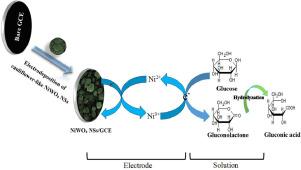Journal of the Taiwan Institute of Chemical Engineers ( IF 5.5 ) Pub Date : 2021-01-12 , DOI: 10.1016/j.jtice.2021.01.003 Fariba Mollarasouli , Mir Reza Majidi , Karim Asadpour-Zeynali

|
This work introduces simple electrodeposition of nickel tungstate nanostructures (NiWO4 NSs) as an electrocatalyst material for the development of a non-enzymatic glucose biosensor. We report a straightforward route for electrosynthesis of NiWO4 NSs on the glassy carbon electrode (GCE) surface by performing two electrochemical steps for the first time. In the first step, the Ni–W alloy was electrodeposited on carbon substrate at a constant potential of -1.4 V (vs. SCE) for 60 s in an ammoniacal buffer (pH = 8.0) containing an appropriate amount of NiSO4 and Na2WO4. 2H2O. In the next step, Ni–W alloy was converted to the cauliflower nanostructured NiWO4 by applying a cyclic voltammetric (CV) treatment in 1.0 M NaOH solution for 15 cycles at the scan rate 50 mV s−1. The surface morphology, elemental composition, crystal structure of NiWO4 NSs were studied by FESEM, EDX, and XRD analysis, respectively. The NiWO4 NSs/GCE nanosensor exhibited excellent electrocatalytic activity towards glucose in an alkaline medium. The proposed non-enzymatic glucose biosensor possessed excellent selectivity obtained at potential (0.6 V vs. SCE) in KOH 0.1 M, and outstanding long term stability. Furthermore, it showed a low detection limit of 0.15 µM with a high sensitivity of 1200 μA mM−1 cm−2 over the linear range of 0.5–280 µM in KOH 0.1 M. Finally, the practical application of the proposed sensor was successfully evaluated by determining the glucose concentration of human blood with the satisfactory results.
中文翻译:

通过容易地电沉积菜花状NiWO 4纳米结构,增强非酶法葡萄糖生物传感器的活性
这项工作介绍了钨酸镍纳米结构(NiWO 4 NSs)作为电催化剂材料的简单电沉积,用于开发非酶促葡萄糖生物传感器。我们报告了通过首次执行两个电化学步骤,在玻碳电极(GCE)表面上电合成NiWO 4 NS的简单途径。第一步,在含适量NiSO 4和Na 2的氨水缓冲液(pH = 8.0)中,以-1.4 V(vs. SCE)的恒定电势将Ni-W合金电沉积在碳衬底上60 s。WO 4。2H 2 O.在下一步骤中,Ni-W合金转化成纳米结构NIWO花椰菜4通过在1.0 M NaOH溶液中以扫描速率50 mV s -1进行循环伏安(CV)处理15个循环。通过FESEM,EDX和XRD分析分别研究了NiWO 4 NSs的表面形貌,元素组成和晶体结构。NiWO 4 NSs / GCE纳米传感器在碱性介质中对葡萄糖表现出出色的电催化活性。拟议中的非酶葡萄糖生物传感器具有在0.1 M KOH中的电势下(0.6 V vs. SCE)获得的出色选择性,以及出色的长期稳定性。此外,它的检测限为0.15 µM,灵敏度为1200μAmM -1 cm -2 在KOH 0.1 M中0.5-280 µM的线性范围内。最后,通过测定人血中的葡萄糖浓度,成功评估了所提出传感器的实际应用,结果令人满意。











































 京公网安备 11010802027423号
京公网安备 11010802027423号